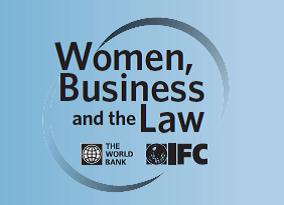Getting a Job: Legal Gender Map of 141 Economies
Mapping the Legal Gender Gap in Getting a Job
 Mapping the Legal Gender Gap in Getting a Job describes and analyzes data on gender differentiated labor regulations from 141 economies. The data has been sourced from Women, Business and the Law’s 2012 Getting a job indicator, which examines how gender differences in labor law may affect women’s incentives and ability to get jobs. The note covers: working hours and industry restrictions; parental benefits; retirement ages; and legal rights in the workplace.
Mapping the Legal Gender Gap in Getting a Job describes and analyzes data on gender differentiated labor regulations from 141 economies. The data has been sourced from Women, Business and the Law’s 2012 Getting a job indicator, which examines how gender differences in labor law may affect women’s incentives and ability to get jobs. The note covers: working hours and industry restrictions; parental benefits; retirement ages; and legal rights in the workplace.Some gender based differences in labor law may increase job opportunities for women, while others serve to limit them. The note describes regional trends in labor and employment law for women, discusses the most recent reforms and analyzes which policies may help to increase women’s participation in the labor force. Mapping the Legal Gender Gap in Getting a Job
Working Hours and Restrictions
The report found that 44 economies restrict the working hours of women and 71 limit the industries in which they can work (figure 1). Such restrictions are most common in the Middle East and North Africa and in South Asia, though they exist in every region. Examples include:
- Azerbaijan and Poland have a separate list of work considered especially strenuous or harmful to women’s health in which it is prohibited to employ women.
- In Slovenia, as in many other economies, women are prohibited from working underground in mines.
- Bolivia’s restrictions are particularly broad, banning women from working in hazardous and unhealthy jobs, jobs that require heavy lifting, and in occupations that may impair their morals and “good customs.”
- Jamaica’s law prohibits night work for women except in a few industries such as packing fruit, nursing, and hospitality.
- The Arab Republic of Egypt’s law states that the minister of labor can issue regulations on when women can work at night or in jobs considered unwholesome and morally harmful.
- India has different regulations for shop and factory workers, with female shop workers able to work slightly later hours than female factory workers. Women are prohibited from working near cotton openers or in jobs deemed unsafe by state governments.

Parental benefits
Of the 141 economies covered in Women, Business and the Law 2012, only Lesotho, Papua New Guinea, and the United States do not require paid maternity or parental leave. Parental benefits for men (either through paternity or parental leave) are far less common. Only 82 economies require parental benefits for men, and in only 73 it is paid.
Just 48 economies offer parental leave, and in only 34 is the benefit paid. Parental leave is more common in middleand high-income economies. Of the 30 high-income OECD economies, 28 have parental leave, as do 19 of 23 economies in Europe and Central Asia. No economy in Latin America and the Caribbean, the Middle East and North Africa, South Asia, or Sub-Saharan Africa grants parental leave. In East Asia and the Pacific only Taiwan, China, offers this benefit. (Figure 2)
In approximately 50 percent of the economies that provide paid maternity leave, governments pay the full costs of maternity benefits. In 22 percent the costs are shared between firms and governments, and in 28 percent employers pay the full cost.

Retirement and pensions
Women, Business and the Law’s getting a job indicator captures the statutory retirement age in the private sector, the minimum pensionable age in the private sector, and whether it is mandatory to retire at the statutory retirement age in the private sector. Gender-differentiated retirement ages can affect career prospects, lifetime earnings, pension benefits, and retirement savings, especially as life expectancy increases. Among the economies covered, 52 have lower retirement ages for women (figure 4). None has a higher one.

Legal Rights
The Women Business and the Law’s getting a job indicator covers five areas: whether there are laws or constitutional provisions mandating equal pay for equal work, laws mandating nondiscrimination in hiring based on gender, laws protecting employees from sexual harassment at work, it is illegal to ask questions about a prospective employee’s family status during a job interview, and if workers with young children have any additional legal rights to flexible or part-time work schedules.
Of these areas, laws on equal pay for equal work are the most common, in place in 128 of the 141 economies covered by the report. In addition, 101 have laws on nondiscrimination in hiring, while 75 have laws protecting employees from sexual harassment at work (figure 5).



